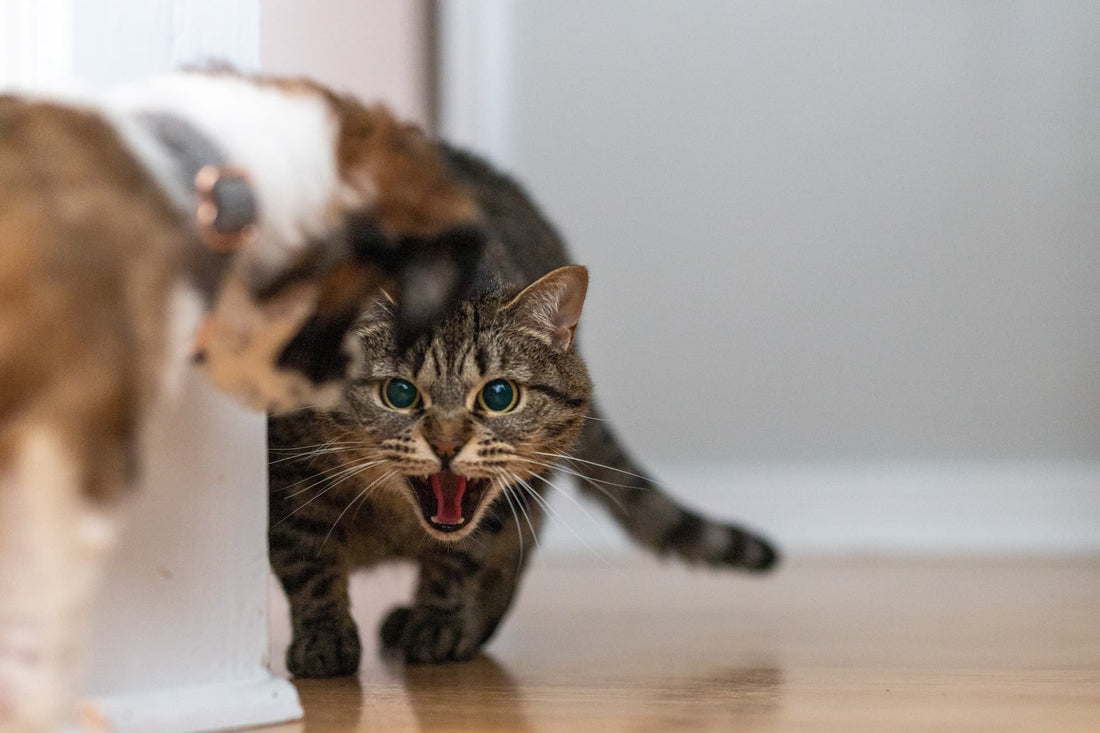
Understanding Cat Play Behavior: Signs of Aggression vs. Healthy Play
Share
Is Your Cat Playing or Showing Aggression?
Have you ever found yourself puzzled by your cat's behavior, wondering if they're engaging in playful antics or displaying signs of aggression? Cats have a unique way of expressing themselves, and understanding their play behavior is crucial for fostering a harmonious relationship with your feline friend. In this blog post, we'll delve into the fascinating world of cat play behavior, learn how to distinguish between playful antics and aggression, identify the signals of healthy cat play, and recognize the subtle signs of aggressive behavior.
Distinguishing Cat Play from Aggression
Cats are known for their playful nature, but their actions can sometimes mimic aggression. Let's explore the key differences between the two to help you better understand your cat's behavior.
1. Body Language Matters
The first clue to differentiate play from aggression lies in your cat's body language. During play, cats typically have a relaxed posture with their tail up or slightly puffed. Their ears may be forward, and their movements are usually fluid and non-threatening. In contrast, aggression often involves stiff body language, arched back, raised fur, and hissing or growling.
2. Playful Pouncing vs. Aggressive Attacks
Playful pouncing is a common behavior among cats, especially kittens. During play, a cat may pounce on toys or even your hand gently. They usually retract their claws and avoid inflicting harm. Aggressive attacks, on the other hand, involve sharp claws, biting, and intent to harm.
3. Vocalizations: Meowing vs. Hissing
Playful cats may meow or chirp during play, while aggressive cats are more likely to hiss, growl, or yowl. Pay attention to the vocal cues your cat provides to understand their emotional state.
4. Play Biting vs. Aggressive Biting
Cats often engage in play biting as a way to interact. Play bites are gentle, with minimal pressure applied. Aggressive biting is forceful and painful, often accompanied by a tense body and dilated pupils.
Healthy Cat Play Signals
Now that you know how to distinguish play from aggression, let's explore the signals of healthy cat play. Understanding these behaviors can help you ensure your cat's playtime is enjoyable and enriching.
1. Chasing and Pouncing
Cats love to chase and pounce on moving objects, whether it's a feather toy, a string, or even a laser pointer. This behavior mimics their natural hunting instincts and provides mental and physical stimulation.
2. Kneading
Kneading is when a cat pushes their paws in and out against a soft surface, like your lap or a blanket. It's a sign of contentment and often occurs during play or when your cat is relaxed.
3. Wrestling with Toys
Cats may wrestle with stuffed toys, grabbing them with their front paws and kicking with their hind legs. This is a healthy outlet for their energy and can help keep them fit.
4. Stalking and Hiding
Cats enjoy stalking and hiding, whether it's stalking a toy mouse or hiding behind furniture and then pouncing on an unsuspecting "prey." It's a playful and mentally stimulating activity.
Identifying Aggressive Cat Behavior
Recognizing aggressive behavior in your cat is crucial to maintaining a safe and peaceful environment for both you and your pet. Here are some signs to watch out for:
1. Hissing, Growling, or Spitting
These vocalizations are clear indicators of aggression. If your cat is making these sounds, it's essential to proceed with caution.
2. Ears Back and Flattened
When a cat's ears are pinned back or flattened against their head, it's a sign of aggression. This posture often accompanies aggressive behavior.
3. Raised Fur and Arched Back
An agitated cat may puff up their fur and arch their back to appear larger and more threatening.
4. Tail Lashing or Bushy Tail
A cat with an aggressively lashing tail or a bushy tail is likely upset and ready to defend themselves.
A Happy and Healthy Feline Relationship
Understanding your cat's play behavior and being able to distinguish it from aggression is essential for nurturing a happy and healthy relationship with your feline companion. By paying attention to their body language, vocalizations, and actions, you can ensure that playtime is enjoyable and safe for both you and your cat.
So, are you ready to decode your cat's behavior and foster a stronger bond? By recognizing the signs of healthy play and aggression, you can ensure a harmonious life with your feline friend.
Share your own experiences with cat play behavior or any questions you have in the comments below, and don't forget to sign up for our newsletter to receive more valuable insights on understanding and caring for your beloved cat.
Happy Play!
